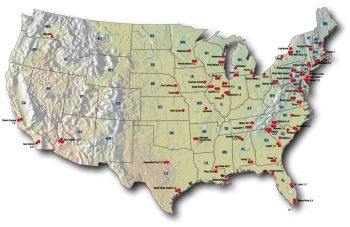
Publisher:
Bonnie King
CONTACT:
Newsroom@Salem-news.com
Advertising:
Adsales@Salem-news.com

~Truth~
~Justice~
~Peace~
TJP
Mar-25-2011 19:41

 TweetFollow @OregonNews
TweetFollow @OregonNews
Reactor Reax: Weekly Report on Nuclear Power
Salem-News.comThe latest stories making the news...
 Red dots on map shows the 104 U.S. nuclear reactor sites. Courtesy: world-nuclear.org |
(WASHINGTON D.C.) - As news continues to develop in Japan from the recent disaster at the Fukushima nuclear facility; we learn that what is already a deadly, tragic scenario, could become much worse, depending on how events unfold.
This collection of stories is published at a time when questions about the dangers of nuclear radioactivity are at their highest. There are 104 nuclear reactor facilities in the United States, many people do not realize that. They are sporadic on the west coast, yet plentiful in the southern states and along the eastern seaboard.
The advanced building of nuclear power facilities comes at a time when solar technology is soaring, as well as a long list of other clean energies that do not create radioactive waste or pose an imminent danger to the public.
A Japanese citizen was quoted saying, "This time we did it to ourselves", referring to Japan's past as a nation where atomic bombs were dropped on not one, but two major civilian population centers; Hiroshima and Nagasaki.
- By Salem-News.com News Editor Tim King
Here is the latest:
Nuclear Costs to Soar Post Japan Disaster, GigaOm, March 25, 2011. "The nuclear situation in Japan is still not under control, and reports of exposed workers, contaminated food, and possible leaking reactor cores continue to come out of the pummeled nation. But researchers are already predicting how the disaster will affect the nuclear industry and — according to Mark Cooper, a senior fellow at Vermont Law School's Institute for Energy and Environment — construction costs of nuclear reactors for the foreseeable future will soar following the problems in Japan."
Nuclear power in US: public support plummets in wake of Fukushima crisis, Christian Science Monitor, March 22, 2011. "The massive earthquake that threatened a meltdown at Japan's Fukushima I nuclear plant has dramatically eroded public support for building new nuclear power plants in the US, throwing into question the "nuclear renaissance" hailed by industry advocates, new polls show."
Poll: U.S. loses nuclear support after Japan quake, USA Today, March 22, 2011. "As Japan's nuclear crisis continues, fewer than half of Americans now support the construction of new U.S. nuclear power reactors and most prefer renewable energy and energy efficiency, a new survey reveals."
A quarter of U.S. nuclear plants not reporting equipment defects, report finds, Washington Post, March 24, 2011. "More than a quarter of U.S. nuclear plant operators have failed to properly tell regulators about equipment defects that could imperil reactor safety, according to a report by the Nuclear Regulatory Commission's inspector general. Operators of U.S. nuclear power plants are supposed to tell the NRC when pieces of equipment 'contain defects that could create a substantial safety hazard,' regulations say."
U.S. nuclear industry: Not safe enough, (op-ed by Joel R. Reynolds, senior attorney and director of the Southern California program of the Natural Resources Defense Council), Los Angeles Times, March 18, 2011. "The specter of nuclear disaster in Japan has prompted nuclear industry representatives in the United States to offer reassurances that no such thing could happen here. Our plants are better designed, they say, our system of government oversight is stricter, and a quake of that magnitude is highly unlikely. If you believe that, I have a fail-safe blowout preventer from the Gulf of Mexico I want to sell you."
Nuclear industry shielded from big disaster costs, CNN, March 25, 2011. "Aside from the human toll a worst-case scenario nuclear reactor meltdown would cause, American taxpayers could also be stuck paying hundreds of billions in damages. But the industry would only be on the hook for a tiny fraction of that -- even if it was to blame."
Krauthammer: 'Nuclear Energy is Dead' After Japanese Crisis, NewsBusters, March 20, 2011. "It was likely not a surprise to 'Inside Washington' viewers that most of the usual suspects on the panel Friday saw the crisis in Japan as not being good for the future of nuclear powered electrical plants in this country. What certainly must have raised a couple of eyebrows though was the strongest opposition to any further construction of such facilities coming from lone conservative Charles Krauthammer."
Public more supportive of renewable investments as a result of Japan crisis, poll says, The Hill, March 22, 2011. "The majority of people in the U.S. are more supportive of investments in renewable energy and energy efficiency as an alternative to expanded nuclear power as a result of the crisis in Japan, a new poll found."
Imagining The U.S. Without Nuclear Power, NPR/Talk of the Nation, March 24, 2011. "As Japan struggles to contain its nuclear crisis, countries around the world are reconsidering their use of nuclear energy. While the Obama administration continues to support nuclear power as a clean energy source, the crisis in Japan has many questioning the safety of U.S. nuclear plants."
Subsidizing Risk, (op-ed by Taxpayers for Common Sense), Hawaii Reporter, March 21, 2011. "Nuclear power in the United States has always operated with a strange dichotomy: the profits are private, but the risks and liability are born by the public. The nuclear industry is one of the most heavily subsidized energy sectors and has been since its development in the 1940s. One practically incalculable subsidy is the Price Anderson Act, which is the federal (read — taxpayer) assumption of liability in the event of a catastrophic accident."
Got Plans for the Next 25,000 Years?, CNBC, March 21, 2011. "It turns out that nuclear waste has more in common with the financial world than being a metaphor for the worst of its toxic assets. Nuclear waste—some of which remains disastrously radioactive for 100,000 years—turns out to be the ultimate tail risk.
How the 'Peaceful Atom' Became a Serial Killer, Mother Jones, March 24, 2011. "When nuclear reactors blow, the first thing that melts down is the truth. Just as in the Chernobyl catastrophe almost 25 years ago when Soviet authorities denied the extent of radiation and downplayed the dire situation that was spiraling out of control, Japanese authorities spent the first week of the Fukushima crisis issuing conflicting and confusing reports. We were told that radiation levels were up, then down, then up, but nobody aside from those Japanese bureaucrats could verify the levels and few trusted their accuracy. The situation is under control, they told us, but workers are being evacuated. There is no danger of contamination, but stay inside and seal your doors."
After Japan, plans for more nuclear power plants are all but over, Minnesota Post, March 23, 2011. "Despite the Legislature's attempt to lift Minnesota's 17-year moratorium on new nuclear power plants and President Obama's plan that taxpayers assume the financial risk of building several more plants in the United States, the morass of issues surrounding nukes makes it unlikely that a new fission nuclear plant will be operational in Minnesota for at least the next half century."
"Reactor Reax" is featured on NuclearBailout.org, a Web site maintained by Physicians for Social Responsibility.
Articles for March 24, 2011 | Articles for March 25, 2011 | Articles for March 26, 2011




Salem-News.com:

Terms of Service | Privacy Policy
All comments and messages are approved by people and self promotional links or unacceptable comments are denied.
JDA April 7, 2011 10:08 pm (Pacific time)
In the aftermath of the latest 7.1 magnitude aftershock in Japan, Matsuko Ito, who has been living in a shelter in the northeastern city of Natori since the tsunami, remarks "There's no getting used to the terror of being awoken by shaking." She started screaming when the quake struck around 11:30 p.m. "Something has changed," she said. "The world feels strange now. Even the way the clouds move isn't right."
g March 25, 2011 8:56 pm (Pacific time)
the half life of nuclear waste/plutonium is 240,000 years so it will be around for half a million years...a micro mm in your lungs will give you cancer.this is what is leaking (among other things) from #3 Fukushima's breached core covering.
[Return to Top]©2026 Salem-News.com. All opinions expressed in this article are those of the author and do not necessarily reflect those of Salem-News.com.